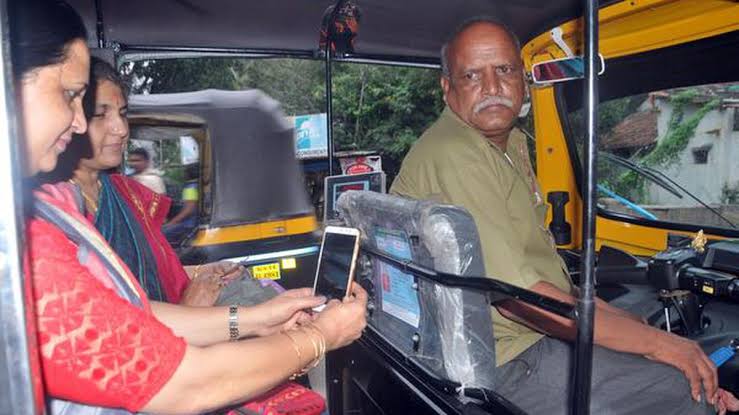Preface
The quantity of e-rickshaws has increased dramatically in recent years in a number of regions, offering an economical and environmentally beneficial form of transportation. These cars, which provide an alternative to conventional cars and cabs, have completely changed urban transportation. Nevertheless, their quick growth has resulted in serious problems with traffic congestion, which have an effect on commuter safety and road efficiency. District Magistrate S Rajalingam has launched a new endeavor to manage the growing traffic issues brought on by the spread of e-rickshaws in order to address these issues. With the help of a well-planned zone-by-zone layout, this QR code and sticker campaign aims to optimize traffic flow and lessen congestion.

Comprehending the Issue of Traffic Congestion
The multidimensional problem of traffic congestion impacts urban centers all over the world. Keeping cars on the road and cities growing at the same time makes traffic management more difficult. Even while e-rickshaws are advantageous in many respects, their popularity has made traffic control more difficult.
1. Increased Vehicle Density: The number of cars on the roadways has increased as a result of the e-rickshaw invasion. The current traffic infrastructure may not be able to handle the increase in vehicles, which would cause bottlenecks and congestion.
2. Inadequate Infrastructure and small Roads: A lot of metropolitan locations, particularly in developing districts, have antiquated traffic infrastructure and small roads that are unable to accommodate the increasing number of vehicles, including e-rickshaws. Traffic jams are mostly caused by this mismatch between the quantity of vehicles and the capacity of the infrastructure.
3. Unregulated E-Rickshaw Movement: Generally speaking, e-rickshaws don't follow traffic laws to the letter. Their movement can be erratic and uncontrolled, which exacerbates traffic, particularly in crowded regions.
4. Demand for Parking Has Increased: The popularity of e-rickshaws has led to a rise in the need for parking spots. In high-density locations, a lack of parking spaces can result in double parking and traffic flow blockage.
The Campaign for QR Codes and Stickers
In order to tackle the issues brought about by the increasing number of e-rickshaws, District Magistrate S Rajalingam has launched a QR code and sticker initiative. Through the optimization of e-rickshaw distribution throughout various zones and the regulation of their movement, this effort seeks to establish a more orderly traffic management system.
The Functions of the QR Code and Sticker System
The zone-based setup of the QR code and sticker system is intended to simplify traffic control and reduce congestion. Here's a thorough explanation of how the system works:
1. Stickers and QR Codes Are Issued:
- Distribution: A distinct sticker and QR code will be given to every e-rickshaw. The vehicle registration number and driver details associated with the QR code will be linked.
- Visibility: The sticker that shows the QR code must be attached to the e-rickshaw in a place where it is easily seen. This guarantees that the vehicle can be quickly scanned and identified by traffic management authorities.
2. Spatially-Aware Arrangement:
- Zone Division: There will be multiple zones inside the district, each having specific locations for e-rickshaws to enter and exit. These areas will be thoughtfully designed to provide equitable traffic distribution and lessen congestion.
- Regulated Movement: Entry and exit of certain zones by e-rickshaws will be controlled by a QR code system. To avoid crowding, each zone will have set times and restrictions on the number of e-rickshaws that can enter.
3. Intelligent Tracking and Administration:
- Scanning and Tracking: Real-time e-rickshaw movement will be tracked by traffic management systems using QR code scanners. This will make it possible for authorities to keep tabs on the quantity of e-rickshaws in each zone and quickly resolve any problems.
- Data Analytics: To find patterns and trends in the movement of e-rickshaws, the data gathered through QR code scans will be examined. Making data-driven decisions to enhance traffic management will be aided by this analysis.
4. Alignment with Current Systems:
- Coordination: The traffic management infrastructure currently in place will be integrated with the QR code system. This cooperation will enhance overall traffic control and facilitate a smooth information flow.
- Communication: To make sure that everyone is aware of the new system and its obligations, traffic management authorities will interact with e-rickshaw drivers and other stakeholders.
Advantages of the Campaign for QR Codes and Stickers
Numerous advantages are provided by the QR code and sticker campaign, which addresses several facets of traffic management and congestion control. Here are a few main benefits:
1. Enhanced Flow of Traffic:
- Reduced Congestion: The campaign's goal is to lessen traffic congestion and enhance overall road efficiency by controlling the movement of e-rickshaws and their admittance into various zones.
- Balanced Distribution: By distributing the e-rickshaws according to zones, the arrangement will provide a more even distribution and minimize overcrowding in some locations.
2. Improved Security:
- Reduced Accidents: The probability of accidents brought on by erratic traffic patterns will decrease with improved regulation of e-rickshaw movement. All users of the road will experience safer travel conditions when there is better traffic flow.
Emergency Response: E-rickshaws' real-time tracking will facilitate speedier reactions to mishaps and crises, improving general safety.
3. Effective Traffic Control:
Real-Time Adjustments: Traffic officials will be able to respond quickly to any problems that may occur by being able to track the movement of e-rickshaws in real-time.
- Data-Driven judgments: By obtaining useful insights into traffic patterns, the data gathered via the QR code system will assist authorities in making well-informed judgments regarding traffic management.
4. Assisting E-Rickshaw Operators:
- Clear recommendations: The campaign offers drivers of e-rickshaws clear recommendations to help them better navigate the traffic system and steer clear of possible problems.
- Operational Efficiency: The program will increase e-rickshaw drivers' operational efficiency, resulting in more predictable and seamless travels, by streamlining traffic flow and minimizing congestion.
5. Detrimental Effects:
Decreased Emissions: Better traffic flow will cut down on stop-and-go and idle traffic, which will improve air quality and reduce emissions. This supports the environmental objectives of encouraging eco-friendly transportation.
Resolving Issues and Misunderstandings
The QR code and sticker campaign, according to District Magistrate S Rajalingam, is meant to alleviate traffic congestion rather than impose restrictions on e-rickshaw drivers. The following is how the campaign responds to typical worries:
\
Training and Implementation
Careful strategy and execution are necessary for the QR code and sticker campaign to be implemented successfully. Here is a summary of the main actions that are involved:
1. Organization and Getting Ready:
- Infrastructure Setup: To support the campaign, the necessary infrastructure, such as QR code readers and monitoring systems, will be installed.
Distribution of Materials: Training materials will be developed, and e-rickshaw drivers will receive stickers and QR codes.
2. Education and Assistance:
- Driver Training: To acquaint oneself with the new system, e-rickshaw drivers will participate in training sessions. The usage of QR codes, zone-by-zone planning, and adherence to traffic control regulations will all be covered in the training.
- Support Services: If drivers have any queries or concerns about the new system, support services will be here to help.
3. Testing Pilots:
Testing Phase: To assess the efficiency of the QR code system and pinpoint any areas that require improvement, a pilot testing phase will be carried out.
- Evaluation and Adjustments: Before a full-scale rollout, the pilot phase's feedback will be analyzed to determine what needs to be changed.
4. Complete-Scale Execution:
- Rollout: The QR code and sticker system will be implemented throughout the district after a successful pilot test.
Ongoing Monitoring: To guarantee the efficacy of the system and make any necessary adjustments, ongoing monitoring and assessment will be carried out.
Communication and Community Involvement
The QR code and sticker campaign will not be successful without effective community engagement. The district administration intends to interact with the community in the following ways:
1. Open Sessions:
- Information Sessions: To educate the public about the advantages of the QR code system, public sessions are scheduled. In these meetings, e-rickshaw drivers and locals alike will have a chance to voice concerns and offer suggestions.
2. Miscellaneous Information:
- Brochures and Flyers: The general public and e-rickshaw drivers will get informational brochures and flyers. These documents will outline the new system and offer compliance advice.
- Online Resources: A website will be established to offer specifics regarding the QR code system, along with updates, Frequently Asked Questions, and support contact information.
3. Involvement of Stakeholders:
E-Rickshaw groups: To guarantee that drivers receive adequate information and assistance during the implementation process, the district administration will collaborate closely with e-rickshaw groups.
- Local Businesses and Residents: By interacting with these groups, we can better understand their worries and resolve any possible problems with the new system.
Observation and Assessment
For the QR code and sticker campaign to be successful, monitoring and evaluation are crucial. The district administration intends to evaluate the campaign's efficacy in the following ways:
1. Metrics for Performance:
- Traffic Flow Analysis: To assess how the QR code system affects traffic congestion and overall road efficiency, traffic flow measurements will be examined.
- Safety Statistics: To evaluate the campaign's effect on road safety, accident and safety data will be examined.
2. Collection of Feedback:
- Surveys and Feedback Forms: Commuters, e-rickshaw drivers, and other stakeholders will be consulted through surveys and feedback forms.
- Public Forums: These will offer a stage for debating the campaign's effects and obtaining recommendations for enhancements.
3. Ongoing Enhancement:
Adjustments and Enhancements: The required modifications and improvements will be made to the QR code system in light of the evaluation's findings and user feedback.
- Future Planning: The campaign's lessons will guide upcoming initiatives and strategies for traffic control.
Prospects for the Future and Growth
The initiative using QR codes and stickers is an example of a progressive way to handle traffic congestion brought on by e-rickshaws. If the approach is effective, it might be extended to other districts dealing with comparable issues. Here are some predictions for the future:

1. Modification and Copying:
- Other Districts: If the campaign is successful in the current district, it may be adopted in other areas where there is a high density of e-rickshaws and traffic congestion.
Scalability: The system's scalability enables it to be adjusted to various metropolitan environments and traffic control requirements.
2. New Developments and Improvements:
- Technology Integration: To better optimize traffic management, future improvements may involve incorporating cutting-edge technology like artificial intelligence and machine learning.
- Public Feedback: Continuous public input will be essential to enhancing and perfecting the system.
Results
In an effort to alleviate the traffic congestion brought on by the rise in e-rickshaws, District Magistrate S Rajalingam launched a campaign featuring QR codes and stickers. The program intends to improve traffic flow, increase safety, and help e-rickshaw drivers by introducing a zone-wise structure and utilizing real-time monitoring through QR codes. This innovative technique shows a dedication to efficient traffic management and the welfare of the community by offering a well-rounded solution to a challenging issue. The campaign's impact will be rigorously observed as it moves forward, and the lessons acquired could inform future innovations and methods for traffic control.












